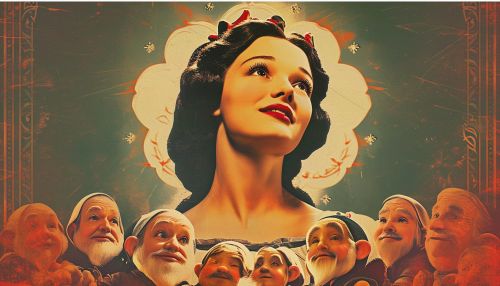Snow White and the Seven Dwarfs (1937 film)
Production
"Snow White and the Seven Dwarfs" is a landmark film in the history of animation. Produced by Walt Disney and released by RKO Radio Pictures in 1937, it is considered the first full-length animated feature film. The film was directed by David Hand, with William Cottrell, Wilfred Jackson, Larry Morey, Perce Pearce, and Ben Sharpsteen serving as sequence directors.


The film was based on the German fairy tale "Schneewittchen" by the Brothers Grimm, and was the first in the series of animated feature films produced by Disney. The story revolves around Snow White, a princess whose wicked stepmother, the Queen, becomes jealous of her beauty and orders her to be killed. However, Snow White escapes into the forest and finds refuge in the home of seven dwarfs.
Plot
The film begins with the Queen consulting her magic mirror, asking who the fairest one of all is. The mirror reveals that it is Snow White, which enrages the Queen. She orders a huntsman to take Snow White into the forest and kill her, bringing back her heart in a jeweled box as proof. However, the huntsman cannot bring himself to kill Snow White and tells her to run away.
Snow White stumbles upon a small cottage in the forest, which is the home of seven dwarfs: Doc, Grumpy, Happy, Sleepy, Bashful, Sneezy, and Dopey. They allow her to stay with them, and she takes care of them in return. Meanwhile, the Queen discovers that Snow White is still alive and decides to kill her herself.
The Queen disguises herself as an old peddler woman and visits the dwarfs' cottage while they are away. She tricks Snow White into biting into a poisoned apple, causing her to fall into a deep sleep that can only be broken by "love's first kiss". The dwarfs return to find Snow White seemingly dead and, believing her to be truly dead, they place her in a glass coffin.
A prince, who had previously met and fallen in love with Snow White, learns of her eternal sleep and visits her coffin. Saddened by her apparent death, he kisses her, which breaks the spell. Snow White awakens and the prince takes her to his castle, while the dwarfs and woodland creatures celebrate the Queen's defeat.
Reception and Legacy
"Snow White and the Seven Dwarfs" was a major success upon its release, both critically and commercially. It was praised for its innovative animation techniques, engaging story, and memorable characters. The film received an honorary Academy Award in 1939, and in 1989, it was added to the National Film Registry by the Library of Congress for being "culturally, historically, or aesthetically significant".
The film's success paved the way for future animated feature films and established Walt Disney Productions as a leader in the animation industry. It also led to the creation of other classic Disney films, such as "Cinderella", "Sleeping Beauty", and "The Little Mermaid".
Impact on Popular Culture
"Snow White and the Seven Dwarfs" has had a significant impact on popular culture. The characters of Snow White and the seven dwarfs have become iconic figures, appearing in numerous adaptations, parodies, and merchandise. The film's songs, such as "Heigh-Ho", "Someday My Prince Will Come", and "Whistle While You Work", have become classic Disney songs.
The film also influenced the development of animation as a serious art form. It demonstrated that animated films could be emotionally engaging and tell complex stories, not just serve as light entertainment for children. This has had a lasting impact on the animation industry, influencing the works of other animation studios and independent animators.
